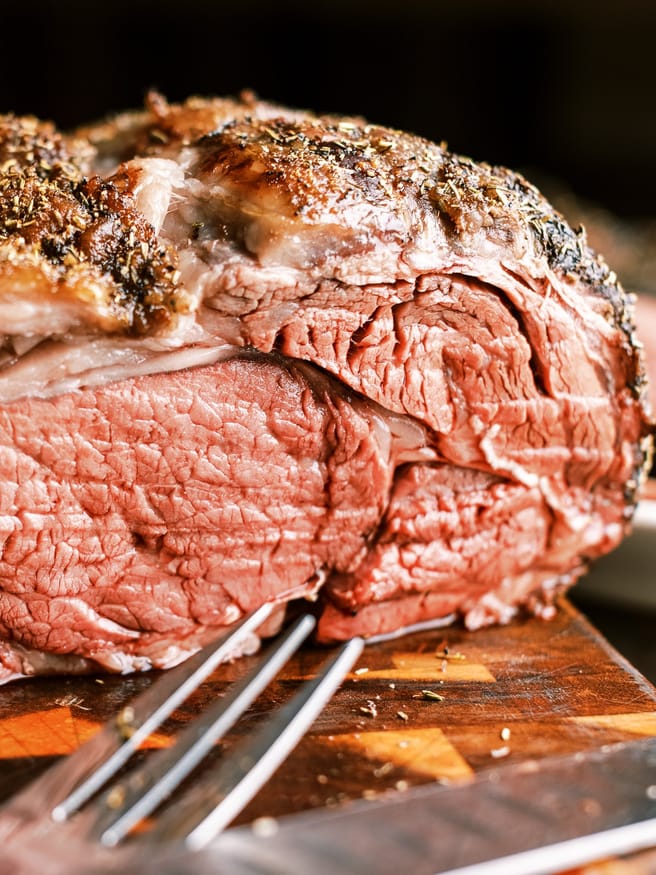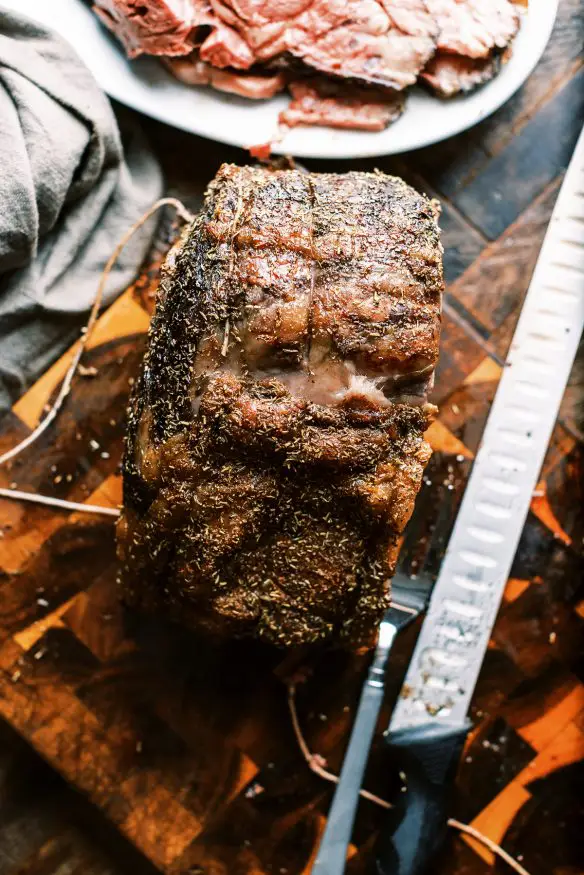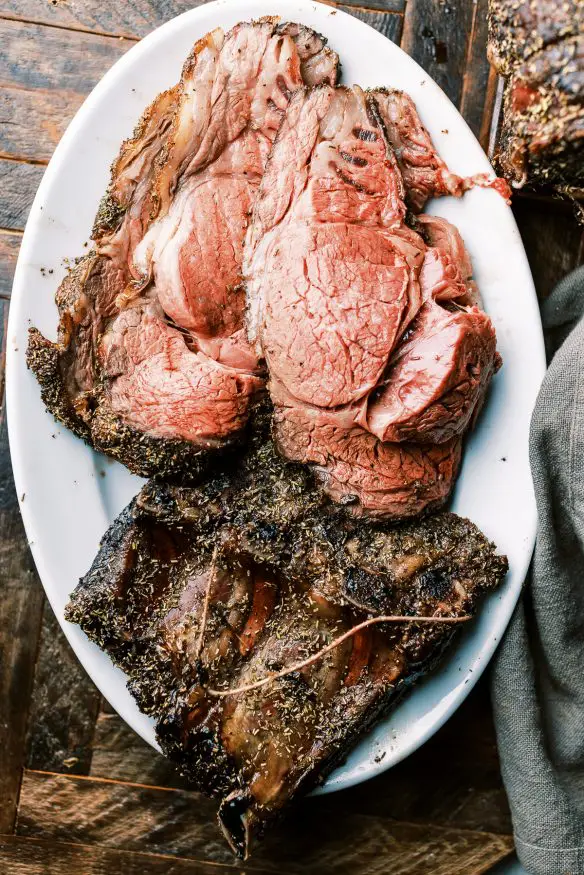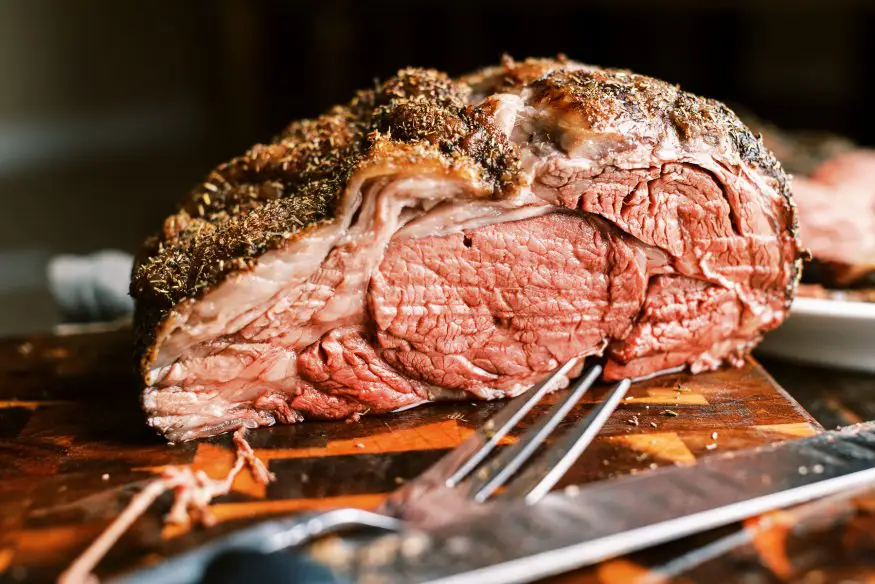Garlic Herb Prime Rib Roast (Convection Oven Method)
(
REVIEWS)
PREP:
15 minutes
TOTAL:
5 hours 15 minutes
SERVES:
8

Table of contents
- Ingredients Needed
- Bone in vs boneless rib roast
- Equipment Needed for a Garlic Herb Prime Rib Roast
- How to Cook a Prime Rib Roast in a Convection Oven
- How to Serve Your Garlic Herb Prime Rib Roast
- Expanded FAQ for Prime Rib Roast
- Variations and Leftover Ideas for Prime Rib Roast
- Side Dishes to Complement Your Prime Rib Roast
When I think of the holidays, a prime rib dinner immediately comes to mind. There’s something magical about slicing into a perfectly cooked garlic herb prime rib roast, especially when it’s prepared in a convection oven.
The rich flavors, the tender pink meat, slathered in creamy horseradish sauce and swimming in au jus is just so satisfying, hearty and just makes for the perfect Christmas dinner, and all other special occasions you’re celebrating.
My kids might skip the horseradish, but they can’t resist dipping their slices of roast into the au jus. It’s a tradition in our house, and now, I’m going to share my secret recipe with you.
Oh, and i get it, this can be an expensive cut of meat. So I’m making this article as exhaustive as possible to make sure you get a perfectly cooked holiday roast the first time!
Ingredients Needed
Prime Rib Roast: For the best results, look for a well-marbled usda prime grade rib roast, this is most likely a once a year meal so lets really show the love here! The marbling contributes to the flavor and juiciness of the meat, so it’s worth investing in quality. If you can, select a roast with an even layer of fat on top, known as the fat cap, which will baste the meat as it cooks, enhancing the texture and taste.
Kosher Salt: I normally go with Diamond Crystal Kosher salt for these types of recipes. The coarse grains allow for better control when seasoning your roast. It sticks to the meat well and dissolves slowly, ensuring a perfectly seasoned crust.
Freshly Ground Black Pepper: Freshness is your friend on this one. Pre-ground pepper can lose its potency, so for a pungent kick, grind your peppercorns just before seasoning the roast. An electric, or large hand crank grinder will make this task go by quicker
Garlic: Go for fresh garlic over pre-minced or powdered. Fresh garlic will give a more robust and sharp flavor that infuses the meat during cooking. Crushing your garlic cloves before chopping releases more oils and intensifies the taste.
Fresh Herbs (Rosemary, Thyme, Sage): ALWAYS FRESH for a rib roast – the aromatic qualities are unmatched. If possible, source them from your garden or a local farmer’s market. The freshness of the herbs will bring a vibrant and herby backdrop to the richness of the meat. Rosemary brings a woody fragrance, thyme adds a subtle earthiness, and sage provides a slight peppery note.
Olive Oil: Choose a high-quality extra virgin olive oil for its fruitiness and peppery notes which will complement the herbs and garlic. It should have a good viscosity, which helps to adhere the rub to the roast and create a beautiful crust.
Horseradish: For the sauce, the potency of freshly grated horseradish is unparalleled. If you’re buying pre-prepared horseradish, look for jars labeled ‘prepared horseradish’ rather than ‘horseradish sauce’, which can be milder and creamier.
Beef Broth: Homemade beef broth is the gold standard for your au jus, as it’ll have a depth of flavor that can’t be matched by store-bought versions. If you’re in a pinch, choose a low-sodium, high-quality brand that lists beef and natural flavors at the top of its ingredients.
Remember, the quality of your ingredients is directly proportional to the quality of your final dish. Quality ingredients will transform a good dish into a great one, and this perfectly cooked roast is no exception.
Bone in vs boneless rib roast
Yes, there are several reasons one might choose a bone-in versus a boneless rib roast, and it often comes down to personal preference, cooking method, and presentation.
Here are some considerations for each:
Bone-In Rib Roast:
- Flavor: Many chefs and home cooks believe that cooking meat on the bone gives it more flavor. The bones are said to add depth to the taste and richness to the overall dish.
- Moisture and Insulation: The bones provide a degree of insulation during cooking, which can result in a more tender and moist roast. They can help prevent overcooking and contribute to an even cooking process.
- Presentation: A bone-in rib roast can make a more dramatic presentation at the table. The classic look of the standing rib roast is often associated with tradition and celebration.
- Added Value: After the meal, the bones can be used to make stocks and broths, adding value and flavor to future meals.
Boneless Rib Roast:
- Ease of Carving: Without the bones, a boneless roast is much easier to carve. You can slice it into consistent portions without navigating around the bones.
- Cooking Time: A boneless roast typically cooks faster than a bone-in roast because the heat penetrates the meat more directly.
- Seasoning Penetration: With a boneless roast, you can season the inside surface where the bones were removed, which can lead to more even seasoning throughout the meat.
- Portion Control: Without the bones, it’s easier to estimate portion sizes and buy the exact amount of meat you need, which can be more cost-effective.
Considerations for Selection:
- Cooking Preference: If you prefer a slightly more foolproof method that may result in a juicier roast, bone-in is the way to go. For a quicker cooking time and easier carving, choose boneless.
- Flavor vs. Convenience: If your priority is maximum flavor and presentation, and you don’t mind the extra work involved in carving, a bone-in roast is ideal. If convenience and ease of serving are your primary concerns, boneless is better.
- Guest Preferences: If you know your guests enjoy gnawing on bones or prefer the look of a bone-in roast, that could sway your decision. Conversely, if you’re serving a crowd that might be put off by bones, go boneless.
I personally like to get a bone-in prime rib with the bone separated. You can have a butcher prepare it this way, and tie it with twine to keep it intact while cooking. Once cooked, you can remove the twine and the bone easily separates allowing for easy serving, while getting the benefits of moisture and insulation with a bone-in rib roast.

Equipment Needed for a Garlic Herb Prime Rib Roast
Convection Oven: A modern convection oven is key to achieving a uniformly cooked prime rib with a delectable crust. Look for one with adjustable racks and accurate temperature settings. This ensures even air circulation and consistent heat distribution, crucial for the perfect roast.
Roasting Pan: Opt for a heavy-duty roasting pan with a rack. The weight ensures even heat conduction, while the rack elevates the rib roast, allowing the hot air to circulate freely, cooking it evenly from all sides. A pan with high sides will also catch splatters and make a better au jus.
Reliable Meat Thermometer: A digital meat thermometer is indispensable. It provides instant, accurate readings, ensuring your prime rib roast reaches the exact level of doneness and desired temperature. For consistency and safety, invest in one that is known for durability and precision.
Carving Knife: The right carving knife can make a world of difference. A long, sharp knife is essential for clean cuts. Consider a high-carbon stainless steel knife which will maintain its edge longer and resist corrosion. A good handle grip adds control and comfort as you slice through the roast.
Cutting Board: A sturdy wooden cutting board with a juice groove is your best bet. Wood is gentle on knife blades and the groove will prevent meat juices from spilling onto your countertop. Make sure it’s spacious enough to handle a large roast and is from a sustainable source for environmental peace of mind.
Remember, high-quality equipment is a crucial investment for any home chef and can make the difference between a good roast and a spectacular one. These tools not only aid in the cooking process but also ensure safety and enhance the enjoyment of your culinary endeavors. The last thing we want is a trip to the ER on a holiday!
How to Cook a Prime Rib Roast in a Convection Oven
A convection oven is a sure-shot way to make a perfect prime rib, ESPECIALLY if this is your first time. A more recent model oven will get you a uniformly cooked prime rib, while giving accurate temperatures.
Preparation:
- Room Temperature: Begin by letting your prime rib roast sit out until it reaches room temperature, which can take around 2 hours depending on the size. This crucial step ensures even cooking.
- Herb Rub: While the roast warms up, prepare your herb rub. Crush the garlic and finely chop your fresh herbs, releasing their essential oils. Mix with olive oil to form a paste for maximum adherence to the roast’s surface.
- Seasoning: Generously season the roast with kosher salt and freshly ground black pepper before slathering it with your garlic-herb paste. Ensure the entire roast is coated evenly, as this creates the flavor crust.
- Oven Preparation: Preheat your convection oven to a high heat setting — around 500°F (260°C). The initial high heat will sear the outside of the roast, locking in the juices. Think of this as a reverse sear method.
Cooking:
- Initial Sear: Place your seasoned roast in the roasting pan and into the preheated oven. Roast for about 20 minutes to form a rich, brown crust.
- Temperature Adjustment: After the sear, reduce the oven temperature to around 325°F (163°C). The lower temperature will cook the roast slowly, ensuring a tender, evenly cooked interior.
- Cooking Time: Cooking times will vary based on the size of your roast and desired doneness. As a rule of thumb, aim for about 15 minutes per pound for medium-rare. Always use a meat thermometer to check the internal temperature. For medium-rare, you’re aiming for an internal temperature of 130°F to 135°F (54°C to 57°C).
- Convection Cooking: The beauty of a convection oven is its ability to cook more evenly and often quicker due to the circulating air. Keep the oven door closed to maintain a consistent temperature and use the light to check on the roast without opening the oven.
Resting the Roast:
- Rest Before Carving: Once your roast reaches the desired internal temperature, remove it from the oven and let it rest on a cutting board. Tent it loosely with aluminum foil and let it rest for at least 20 minutes. This allows the juices to redistribute throughout the meat, ensuring that each slice is moist and flavorful.
- Final Touches: After resting, slice the roast against the grain. Serve with horseradish cream sauce and au jus that you’ve prepared using the flavorful drippings from the roasting pan.
Pro Tip: If you have an oven with a temperature probe, use it to continuously monitor the internal temperature of the roast without opening the oven door, preserving the convection environment.
By following these detailed steps, you’ll ensure your garlic herb prime rib roast is cooked to perfection using your convection oven, achieving a flavorful crust and a juicy, pink interior that’s bound to impress.

How to Serve Your Garlic Herb Prime Rib Roast
Serving a prime rib roast is about much more than just placing meat on a plate; it’s about crafting an experience that your guests will remember. Here’s how to serve it up your convection roast beef with style and precision:
Determining Serving Size:
- Portion Size: A common rule is to allocate about 1/2 pound of bone-in roast per person or 1/3 to 1/2 pound for a boneless roast. However, for heartier appetites or if you want leftovers, aim for about 3/4 to 1 pound per person.
- Bone-In Roast: When serving a bone-in roast, each rib bone typically serves 2 guests. So, a 4-bone roast would comfortably serve 8 people.
- Boneless Roast: Since there are no bones to take into account, simply divide the total weight of your cooked roast by the number of guests to ensure even portions.
Carving and Presentation:
- Carving Bone-In Roast:
- After resting, transfer the roast to a large cutting board with a well for catching juices.
- Slice down between the rib bones to portion the meat, cutting the sections into thinner slices if desired.
- Arrange the slices on a platter, showcasing the cut side for a visually appealing presentation.
- Carving Boneless Roast:
- Place the rested roast on a stable cutting board.
- Hold the roast steady with a meat fork and slice it across the grain into even slices, about 1/4 to 1/2 inch thick depending on preference.
- Fan the slices out on a serving platter, allowing guests to appreciate the perfectly cooked interior.
Serving Suggestions:
- Accompaniments: Serve with sides that complement the richness of the meat, such as roasted vegetables, creamy mashed potatoes, or a fresh salad.
- Sauces: Offer a range of sauces, such as the traditional horseradish cream, a rich red wine jus, or a homemade beef gravy.
- Wine Pairing: Pair with a robust red wine like a Cabernet Sauvignon or a smooth Merlot to balance the savory flavors of the roast.
- Kid Drink Pairing: Let’s not leave them out, go for a ginger ale, or if you want to match the adults, a red sparkling cider will complement the savory, robust taste of the meat beautifully.
Additional Tips:
- Offer Variety: Provide slices from the end cuts for those who prefer well-done meat and from the center for those who enjoy it more medium-rare roast.
- Warm Plates: Serve on warmed plates to keep the meat at an ideal temperature as guests savor their meal.
- Table Setting: Enhance the dining experience with a beautifully set table, complete with cloth napkins, fine china, and crystal glassware to honor the care you’ve put into preparing the meal. It’s the holidays dag-nabbit lets go all out!
Expanded FAQ for Prime Rib Roast
Pre-Purchase Questions
Look for a well-marbled prime-grade rib roast. The marbling contributes significantly to the flavor and tenderness of the meat.
Plan for about 1/2 pound per person for a bone-in roast, or 1/3 to 1/2 pound for boneless. For hearty appetites or if you desire leftovers, consider up to 1 pound per person.
Bone-in roasts tend to be more flavorful and juicy due to the insulation from the bones, but boneless roasts are easier to carve. Your choice depends on your preference for flavor and convenience.
Yes, you can season your roast up to 24 hours in advance. This acts as a dry brine, enhancing the flavor and tenderness of the meat.
Mid-Cooking Questions
Start with a high heat of around 500°F for the initial sear, then reduce to 325°F for the remainder of the cooking time.
Use a meat thermometer to check for doneness: 120-125°F for rare, 130-135°F for medium-rare, and 140-145°F for medium.
Try to avoid opening the oven door frequently, as it can cause temperature fluctuations. Use the oven light and window to check on the roast.
Let the roast rest for at least 20 minutes after removing it from the oven. This allows the juices to redistribute, ensuring a moist and flavorful meat.
Post-Cooking Questions
Store leftovers in an airtight container in the refrigerator for up to 3-4 days. Reheat gently in a low-temperature oven, covered, to prevent drying out.
Yes, wrap it tightly in aluminum foil and place it in a freezer-safe bag. It can be frozen for up to 3 months.
Leftover prime rib can be sliced for sandwiches, chopped for stews, or added to salads and stir-fries for a protein boost.

Variations and Leftover Ideas for Prime Rib Roast
Expanding on the versatility of prime rib roast, here are some creative variations and ideas for using leftovers, ensuring that every bit of your delicious roast is enjoyed to the fullest.
Variations:
- Herb Encrusted Prime Rib: Mix breadcrumbs with finely chopped herbs and Parmesan cheese. Apply this crust to the outside of the roast in the last 30 minutes of cooking for a crispy, flavorful crust.
- Coffee-Rubbed Prime Rib: For a bold twist, rub your roast with a mixture of ground coffee, brown sugar, and smoked paprika before roasting.
- Mustard and Horseradish Prime Rib: Before roasting, coat your prime rib with a mix of Dijon mustard and prepared horseradish for a tangy, spicy crust.
- Wine-Braised Prime Rib: Slow cook your roast in a bath of red wine, beef broth, and herbs for a tender, flavor-infused variation.
- Pepper-Crusted Prime Rib: Coat your roast generously with cracked black pepper and coriander seeds for a spicy, aromatic crust.
Leftover Ideas:
- Prime Rib Sandwiches: Thinly slice leftover prime rib and serve on crusty bread with horseradish mayo, arugula, and caramelized onions.
- Prime Rib Tacos: Shred the leftover meat and serve in soft tortillas with salsa, avocado, and cilantro for a quick and tasty meal.
- Beef and Barley Soup: Cube the leftover prime rib and simmer with barley, vegetables, and beef stock for a comforting soup.
- Prime Rib Hash: Chop the roast into small pieces and pan-fry with potatoes, onions, and peppers for a hearty breakfast hash. Top with a fried egg.
- Prime Rib Stir-Fry: Slice the roast thinly and stir-fry with a medley of vegetables and a savory sauce for a quick and delicious dinner.
- Beef Stroganoff: Use thinly sliced leftover prime rib in a classic stroganoff sauce with mushrooms and serve over egg noodles.
- Prime Rib Beef Salad: Toss slices of cold prime rib with greens, cherry tomatoes, blue cheese, and a balsamic vinaigrette for a refreshing salad.
These variations and leftover ideas offer creative ways to enjoy prime rib roast in different styles and flavors, making the most out of your meal and reducing food waste.
Side Dishes to Complement Your Prime Rib Roast
I mean sure you can eat garlic herb prime rib eye roast all by itself. But that’s a little lonely, isn’t it?
Here are some side dish ideas that complement the rich flavors of the roast:
- Garlic Mashed Potatoes: Creamy mashed potatoes with roasted garlic and a touch of cream and butter offer a classic, comforting accompaniment.
- Blistered Green Beans: Tender green beans sautéed with slivered almonds and a hint of la spicy soy sauce that is quick and easy to make.
- Yorkshire Pudding: This goes hand and hand with prime rib. These fluffy, savory puddings are a traditional British side that soak up the roast’s juices beautifully.
- Sautéed Mushrooms: Mushrooms sautéed in butter and herbs complement the umami flavors in the prime rib.
- Au Gratin Potatoes: Layers of thinly sliced potatoes baked in a creamy cheese sauce provide a decadent and satisfying side.
- Balsamic Roasted Brussels Sprouts: Brussels sprouts roasted with balsamic vinegar and a touch of honey offer a balance of sweet and tangy flavors.

Garlic Herb Prime Rib Roast
Ingredients
For The Prime Rib:
- 4- pound Prime Rib Roast bone-in, about 1/2 pound per person
- 2 tablespoons Kosher Salt
- 1 tablespoon Freshly Ground Black Pepper
- 4 cloves Fresh Garlic minced
- 1 tablespoon Fresh Rosemary finely chopped
- 1 tablespoon Fresh Thyme finely chopped
- 1 tablespoon Fresh Sage finely chopped
- 1/4 cup Extra Virgin Olive Oil
For The Horseradish Cream:
- 1 cup Sour Cream
- 2-4 tablespoons Prepared Horseradish adjust to taste
- 1 tablespoon Dijon Mustard
- 1 teaspoon White Wine Vinegar
- 1/2 teaspoon Kosher Salt
- 1/4 teaspoon Freshly Ground Black Pepper
For The Au Jus:
- Pan drippings from the roast
- 1 cup Beef Broth
- 2 teaspoons Worcestershire Sauce
- Salt and Pepper to taste
Instructions
Prime Rib:
- Let the roast reach room temperature (about 2 hours).
- Preheat convection oven to 500°F.
- Mix garlic, rosemary, thyme, sage, salt, pepper, and olive oil. Rub evenly on the roast.
- Roast at 500°F for 20 minutes, then lower to 325°F, cooking for about 15 minutes per pound.
- Rest for 20 minutes before carving.
Horseradish Cream:
- Combine sour cream, horseradish, mustard, vinegar, salt, and pepper in a bowl.
- Mix well and adjust horseradish to taste.
- Chill in the refrigerator until ready to serve.
Au Jus:
- After removing the roast, place the roasting pan over medium heat.
- Add beef broth and Worcestershire sauce to the pan drippings.
- Stir, scraping up any browned bits from the pan, and simmer until slightly reduced.
- Season with salt and pepper to taste.


4 Comments
I used to use the “no peek” method for prime rib and it always turned out perfectly. I just got a convection range and I found this website, so glad I did! With convection, the oven cools down fast so the “no peek” method probably wouldn’t work. I followed the instructions (after reading the whole post) and the 6 pound roast I had turned out delicious! Thanks for such a comprehensive recipe!
So glad to hear it, thanks Carolyn!
Just served this at our annual family Christmas celebration. It was my second time making this as I tried it last week for proof of concept. It was surprisingly easy both times and was an absolute show stopper at dinner today! This will be my new go-to dish whenever I’m entertaining.
Glad to hear everyone enjoyed it, Shelby!!